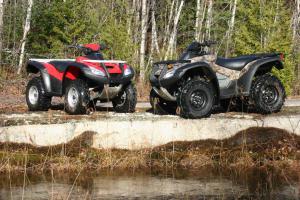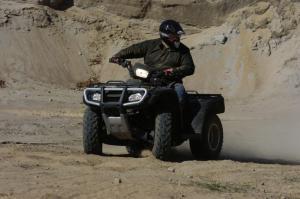The King returns for 2007
Suzuki is a solid player in the ATV business, producing sport-ute bikes that do everything well. The company reserves its KingQuad moniker for very special models, and 2007 is no exception. We have been visiting various US state and national forest trails in north-central Minnesota to evaluate the latest beast from the inventors of the 4-wheeled ATV, and came away impressed—in fact, exhilarated. The fuel-injected 2007 KingQuad 700 delivers handfuls of smooth power and is loaded with useful features for the trail rider or hunter. It also comes at an exceptional price.
The biggest, newest offering from Suzuki is a Tour de Force of some of the best design engineers in the business. The KingQuad is powered by a fuel-injected single-cylinder 695cc dual-overhead cam, wet sump engine. Plasma-spray coated cylinders improve the longevity of this package. The v-belt CVT transmission has engine-braking built in with low and high forward gears plus reverse. Suspension is provided by double-A-arm front and rear with a rear swaybar cleverly hidden in front of the rear diff. The KQ has disc brakes in front and an enclosed fluid-shear brake in the rear. First introduced by Kawasaki, this style of rear brake is one of those nice technology progressions that ATV enthusiasts have been enjoying in recent years. The KingQuad has two bumper-mounted and one handlebar-mounted headlights and a rear-mounted 4.6 gallon gas tank. First impressions reveal best-in-class fit and finish. Everything from the body plastic to the electrical panel under the seat is very clean and well thought out.
Take it to the trails
2007 Argo Avenger Review
2006 Honda FourTrax Rincon Review
In 2003, Honda introduced the Rincon, an ATV that development-wise took a slightly different approach. With its automotive-style automatic transmission, Honda’s first fully independent rear suspension and simple and easy-to-operate 4WD system, the Rincon was a treat to the newcomer and veteran alike.
Simplicity of operation is what the Rincon offered as well as offroad performance. This conclusion, apart from being my own assessment when I first rode it, is what Honda staff (during the initial launch in 2003) also stressed the Rincon’s role in the Honda lineup.
The Rincon, they said, was meant to appeal to new people coming into the sport—and the company accomplished this by making the bike safe, comfortable, but above all easy to ride, in a way that left any new buyer simply accepting that all ATVs must be this user-friendly. That’s the reason that several of the key features of the Rincon mimic automobile functions that are familiar to most adults. The shift lever is placed as it would be in a car and the tranny uses three long gears that shift smoothly and without any harsh bumps or having to search for neutral.
| Specifications FourTrax Rincon GPScape | |
| Model: | TRX680CGA (Camo)/TRX680FGA |
| Engine: | 675cc liquid-cooled OHV single cylinder four-stroke |
| Transmission: | Automatic with hydraulic torque converter. Three forward gears, one reverse |
| Suspension: | Front: independent double-wishbone with 6.9 inches of travel Rear: independent double-wishbone with 8 inches of travel |
| Brakes: | Front: dual hydraulic 180mm disc Rear: single hydraulic disc |
| Tires: | Front: 25×8-12 radial Rear: 25×10-12 radial |
| Length: | 83.2 inches |
| Width: | 47.5 inches |
| Seat Height: | 34.5 inches |
| Ground Clearance: | 10 inches |
| Wheelbase: | 50.8 inches |
| Dry Weight | 600 pounds |
| Fuel Capacity: | 4.5 gallons* (includes 1.1 gallon reserve) *US gallon |
| Pricing: | TRX680FGA Red or OliveC$11,699 MSRP TRX680CGA Camo C$11,999 MSRP |
But despite what seems like a dumbed-down approach to ATV design, the experienced rider would find little to quibble with. Fact is, easy is easy, whether you’re a newbie or a veteran. Now three years on, it’s safe to say that Honda achieved its goal, and the sales prove it.
Still, there is always room for improvement and that’s why Honda had us back up in Quebec showing off the tweaks that it had engineered into the 2006 Rincon. First, they’ve pumped up the power—by increasing the bore from 100mm to 102mm they have added 36cc of displacement. A new higher lift camshaft increases the response in the upper torque range and overall produces a noticeable horsepower difference from the existing 650cc plant. The key change, though, has to be the addition of a new fuel injection system that Honda calls PGM-FI (programmed fuel injection). This system eliminates the manual choke, automatically compensates for altitude, up to 12,000 feet, and also compensates for starting temperature. These main changes, along with a host of smaller ones, represent the fine-tuning of the Rincon for 2006. Some of the others include a new reusable urethane air filter, dual front 180mm disc brakes and new valving in the rear suspension that smoothes out the shock action compared to the previous unit.
For this latest introduction, we rode from Lac Sacacomie, Que. (about 2.5 hours northeast of Montreal) in late November. This was also the location of the initial launch which was held in June of 2003. Looking back at the bugs of June or considering the cold of November, I’ll take November anytime. In fact, we were fortunate to have sunny conditions and a crisp -5 Celsius temperature that (dressed properly) didn’t hinder our party at all. There are more than 1,000 kilometres of maintained ATV trails in the system we rode, which is deep in the Laurentian Mountains. The majority of these trails are of the old logging road variety and what keeps them really interesting is the constant rise and fall of over 1,000 feet in altitude as you ride between the numerous lakes that dot the area. These elevations also make for frequent and beautiful waterfalls along the roads that tend to follow the same courses as the streams that connect the lakes.
In 2004, the Rincon was upgraded with a GPScape model, a feature now carried through the 2006 units. This GPS was integrated into the meter assembly and featured a digital compass, travel direction, compensating clock and storage for up to 100 waypoints. Riding in the Quebec bush, I found this built-in GPScape feature of the Rincon very handy. I say handy because despite the fact that I own two hand-held GPS units, I’ve learned that having to stop, pull the unit out of my pocket, power it up and refer to it is very annoying. The GPScape, by comparison, is always on (powered by the ATV) its simple functions get you to and from where you are going easily—the compass is always showing you which way you’re headed. Best of all, you can refer to it without having to stop, remove your gloves, undue your jacket and wait for a handheld to power up. But most importantly, you can never forget it back at the camp because its part of the bike.
2005 Honda FourTrax Foreman Rubicon Review
The Laurentian mountains of Quebec are a majestic natural setting that has inspired many an artists’ rendering. But the tree-filled site about an hour north of Montreal was also deemed ruggedly suitable enough for Honda to launch and test its new Canadian Trail Edition Rubicon ATV. As Warren Milner, ATV product planer for Honda Canada explains, the Canadian Trail Edition is more than just a stick-on badge. It represents two years of study and testing culminating in a unique coil over shock design that is new from the ground up—and available only in Canada.
The Honda Rubicon model is being used as the platform for these new 2005 Canadian-only editions. In addition the TRX500FG and the TRX400FG are both equipped with Honda’s onboard GPS based navigation system and they both carry the reputation that the Rubicon has gained over the past model years with its Hondamatic transmission that utilizes variable hydraulic pressure and mechanical torque amplification to power the driveshafts. Now add to that a distinctive set of red shocks and you have the CTE.













